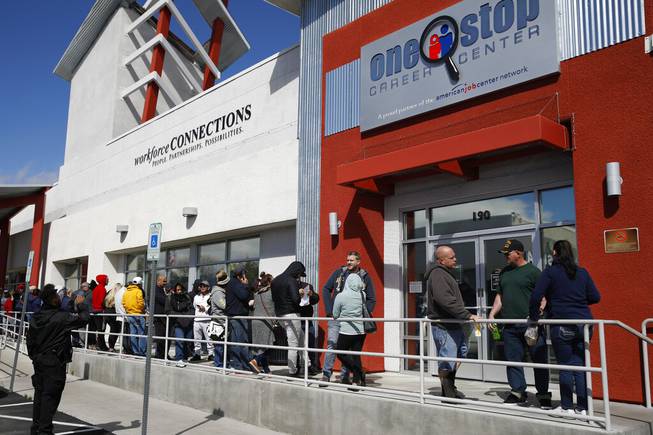
John Locher / AP
In this March 17, 2020 file photo, people wait in line for help with unemployment benefits at the One-Stop Career Center in Las Vegas.
Sunday, May 9, 2021 | 2 a.m.
View more of the Sun's opinion section
Frequently checking your mailbox for a coveted federal stimulus check? Frustrated with how long the process is taking? Angered by the ambiguity as to when payments will be made? Then you may be experiencing some of the problems plaguing your favorite bartender, local entertainer or small-business owner as thousands of Nevadans struggle with the Nevada Department of Employment, Training and Rehabilitation (DETR) for economic relief.
COVID-19 pandemic woes have devastated the state labor market, particularly in tourism-reliant Southern Nevada. April 2020 marks the date Nevada’s unemployment rate hit an unprecedented 29.5%, highest in the nation at that time. The number of Nevadans without a job at one time during the pandemic — 442,217 — may seem incomprehensible, but the devastating effects on the community were distinct.
Those seeking aid in DETR had as much luck as someone trying to find a tourist, a generous slot machine or an open restaurant on the Strip.
Numerous stories of DETR website crashes, full days waiting on the phone for assistance, and the inability to receive unemployment insurance money flooded the nightly news. Issues with DETR were frequently featured in the press, but efforts to fix the broken system seemed like stopgap measures at best. In May 2020, the addition of Pandemic Unemployment Assistance (PUA) funding sought to relieve DETR backlogs and speed up the process, but only led to more chaos. Given the state’s large amount of gig economy workers, who were ineligible for unemployment insurance, it is shocking that Nevada was the last state to implement a PUA claim filing system. A void of confusion, frustration and hopelessness ensued for hundreds of thousands of Nevadans unable to file a claim or receive benefits from UI or PUA.
Unfortunately, these once-in-a-lifetime problems are still a current issue. Since the beginning of 2021, concerns regarding fraudulent claims and unraveling the massive amount of backlogged UI and PUA claims remains a pertinent problem. Recent news stories indicate that some DETR issues may require a decadelong solution. As of March 2021, there were 126,356 unemployed Nevadans, with many more seeking to secure unpaid benefits from 2020. Nevada’s state unemployment rate is stagnated around 8%, the sixth-highest in the nation.
Nevada, there must be a better way.
How can we start the conversation on revolutionizing DETR? Looking toward other states with better unemployment insurance filing systems may hold the answer. For instance, Massachusetts is ranked as the best state for unemployment benefits, and it is easy to understand why. The website has an easy-to-understand section dedicated to COVID-19 unemployment. Turnaround time on most continued claims is two days. Multiple phone numbers for specific departments are listed to facilitate the process.
Moreover, Hawaii also has an exceptional unemployment insurance filing system. The Aloha State’s website offers a vast array of “how to” videos designed to walk claimants through the motions. Hawaii’s website offers more than 10 filing options for COVID-19, while Nevada’s system only offers one generic choice. UI and PUA claims are processed on the same website; Nevada has different systems for UI (DETR) and PUA (Employ NV). Hawaii and Nevada have similar labor markets and experienced a high influx of claimants throughout the pandemic.Yet the differences in the unemployment systems are drastic, illuminating the many shortfalls of DETR.
There is no reason why DETR should be so inefficient. The painstaking process has caused grief among hundreds of thousands of Nevadans. The recent influx of funds through the American Recovery Plan (ARP) offers an unprecedented opportunity to modernize and improve DETR operations, similar to Massachusetts or Hawaii.
Nevada, there is a better way.
How can Nevada accomplish this daunting task? The governor, in partnership with state legislators, needs to craft concrete solutions to address the multitude of DETR’s failures. Specifically, accessibility is an immediate threat to unemployed Nevadans. Those who lack secure broadband access to reach the website at specific times of the day or do not have cellphones to call the helpline are significantly disadvantaged. The system is not designed for low-income workers, who are most likely to not have sufficient technology to access DETR. Notably, the unemployment filing system denies hard-earned, well-deserved benefits to those Nevadans most in need.
Additionally, many potential long-term solutions could modernize the unemployment insurance program. The 81st session of the Legislature has illuminated interesting proposals, including Senate Bill 308, which would require DETR to establish a work-sharing program that pays employees less than their average earnings in time of recession instead of laying workers off. Another idea is to federalize unemployment insurance, much like Social Security, to eliminate discrepancies in states’ unemployment systems.
While these prospective plans are worth considering, action must be taken now to fix the system. Stimulus checks are on the minds of most Nevadans, but the broken unemployment system should be of utmost concern to the governor and legislators. Unemployment insurance is not something people think about until the need arises, but DETR’s perils demonstrate the failure of a state government to modernize its operations in concert with our frail economy. ARP presents a unique opportunity to rectify this problem.
Nevada, commit to a better way.
Katie Gilbertson is a student researcher at Brookings Mountain West and the Lincy Institute at UNLV.
